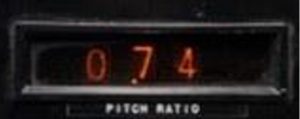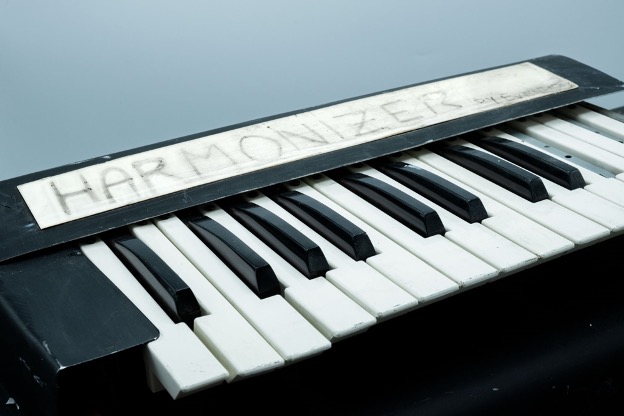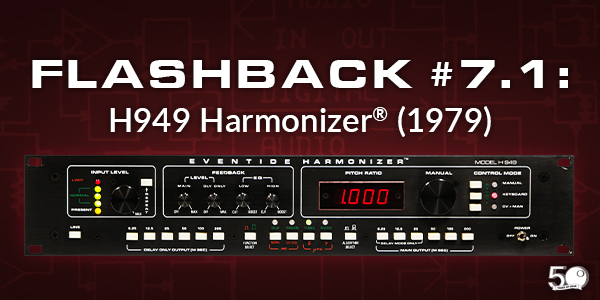
The Hall of Fame
In 2007, 42 years after its invention, Eventide was gobsmacked (assuming Eventide has a gob to smack) to enter the Hall of Fame hand-in-hand with the iconic Theremin.

There’s a lot of history to cover about the conception and development of the Harmonizer so let’s first consider the underlying principle: the interesting phenomenon known as Pitch Change.
The Strange Case of Pitch Change
While Pitch Change is naturally occurring, throughout history, humans would rarely have perceived the effect because the sound source must be traveling at a high enough rate of speed relative to the listener to cause a discernible change in pitch. Why had no one elucidated this effect in our long history? It’s simple; few things moved fast enough! Sound travels at ~750 mph. To notice even a slight pitch change of 2% a sound source with 100% constant pitch would have to be approaching the listener at 15 mph. (Kids whirling objects around on a string were not the scientific observers for which one would have hoped.)

In 1842, Christian Doppler suggested that “the observed frequency of a wave depends on the relative speed of the source and the observer.” Doppler was thinking about star light, not sound, but a wave is a wave is a wave.
Just three years later, Buys Ballot, a Dutchman, demonstrated the Doppler Effect on sound waves by having six tubas play the same sustained note while perched on the front of a speeding locomotive.
The Doppler Effect explained the sound of train whistles speeding past—possibly the first time humans became aware of pitch change (although some lucky human might have noticed the interesting effect on the sound of an arrow whistling past their ear).
Recording Sound: Edison, Berliner, Et Al.
With the first audio recordings by Edison in 1877, a mechanically spinning wax cylinder, pitch change was inevitable. In fact, the challenge became playing a recording at precisely the same rate that it was recorded to prevent pitch change. One can imagine both the fun and consternation that resulted when hearing “Wow” and “Flutter” for the first time. In the 1890s, Emile Berliner invented the gramophone (phonograph), the vinyl disc was born, and pitch change became commonplace.
Tape-based Pitch Change: Les Paul, The Chipmunks & The Beatles
While pitch change is a natural consequence of recording audio, the use of pitch change as an effect wasn’t exploited until the introduction of magnetic tape. Early adopters of tape machines, starting famously with Les Paul, began making dramatic use of pitch change to stand out. Les Paul was first to use his tape recorders to punch in, double track, Varispeed (change pitch) and reverse audio.
Novelty Records
A few brave and wonderfully silly souls took the possibilities of tape-based pitch change to the extreme and had major radio hits! Case in point: The Chipmunks Christmas holiday smash, “Christmas Don’t be Late.” The song was sung at half-speed, then played back and re-recorded at double speed. Those of a certain age will also remember “They’re Coming to Take Me Away, Ha Haaa” by Napoleon XIV. The strange effect of pitch change was at the heart of most novelty hits of the 60s!
“In My Life”
Tape-based pitch change also found utilitarian uses. A classic example is the ‘piano’ solo on The Beatles’ “In My Life”. Here’s an excerpt from a Gear Club podcast with Prof. Alex Case describing George Martin’s crafty and effective ‘trick.’
As Prof. Case describes, George Martin wasn’t able to nail the piano solo at full tempo—too many notes—and so he set the tape machine to record at half-speed and played the part at half-speed one octave down on the keyboard. When he mixed the song, he played the piano solo back at double speed. Worked great, but the timbre made it sound a bit like a harpsichord.
The Curious Case of the Eltro Tempo Regulator

A short-lived intermediate between changing tape speed to change pitch and tempo, until then ineluctably entwined, was the Eltro Tempo Regulator. It was an appliqué for a standard tape deck around which one threaded the tape path. It had a quad tape head with four magnetic pickups 90 degrees apart. And the head rotated!
By selecting the rotation speed and the tape speed, it could increase pitch by keeping the tape speed constant. It could increase tempo by speeding up the tape and rotating the head in a direction contrary to the tape motion, thus keeping the pitch the same. Since head rotation and tape motion could be controlled separately, pitch and tempo could be adjusted separately. This device achieved little commercial success due to its high cost, mechanical complexity, and because it required constant maintenance. This opened the door for digital pitch change, which initially, was only expensive.
Digital Pitch Change
Enter digital audio. As with most forms of audio capture, digital audio is ‘recorded’ at a fixed rate and stored as 1s and 0s in memory chips. The audio can be ‘played back’ (read from memory) at a different rate to achieve pitch change. Unlike mechanical recording, digital recording and playback can happen in ‘real time’ which Richard Factor demonstrated in the years prior to founding Eventide by building this prototype:


Later, in 1974, Eventide introduced a pitch change option for its memory-based DDL1745M and, for the first time, recording engineers could accomplish pitch change without resorting to tape. The stage was set for the development of an effects device that would forever change the world of music production: the Eventide Harmonizer®.
The “Harmonizer” Idea
My original concept for the Harmonizer was for a two-octave keyboard instrument, not a rack mount effects box. An instrument that could be played by a vocalist to instantly generate harmonies. Unlike a traditional keyboard, with each key sounding a specific note, it would act as a controller allowing musicians to select pitch ratios in semitone steps and actually ‘play’ the pitch changer as one would a musical instrument. Pressing center “C” would output unison, unchanged pitch. Pressing high “C” would shift the input up one octave and pressing low “C” would shift one octave down. Vocalists could perform live and instantly add major 3rds, minor 3rds, 5ths, etc. Create harmonies live, keep the backup singers’ checks!
The Harmonizer Prototype
The prototype circuitry was ‘packaged’ in a discarded military chassis with a two-octave keyboard bolted to its top. There were controls for level, pitch, delay, and significantly, feedback—a combo that yielded endless musical possibilities.

Eventide displayed the beastly prototype at a New York Audio Engineering Society convention in 1975. As we were about to bring it to the show floor, we realized it needed a name and so I taped on a white sheet of paper to the top and scrawled “HARMONIZER by Eventide”.

Despite (or due to?) its appearance, it definitely made an impression on attendees! In fact, Jon Anderson of Yes got wind of it and off it flew to Jon’s studio in Beaconsfield near London. The world’s first Harmonizer effects were used on Jon’s solo album Olias of Sunhillow released in June 1976.
We recently spoke with Jon during COVID and here’s his recollection of that first ever use of this new device.
H910 Deep Dive
For more stories about the Harmonizer and other legendary Eventide products, check out this Quarantide episode (featuring Jon Anderson, Clara Ponty, Jean-Luc Ponty, Jean de Reydellet, and Martha Mooke) and this Gear Club episode featuring Alex Case.
Stay tuned for part 2 of this retrospective – The H910, The Product
Check out our previous flashbacks!
- Flashback #1: The Instant Phaser
- Flashback #2.1: The DDL 1745 Delay
- Flashback #2.2: The DDL 1745A Delay
- Flashback #2.3: The DDL 1745M Delay
- Flashback #3: The Omnipressor®
- Flashback #4.1: The H910 Harmonizer®
- Flashback #4.2: H910 Harmonizer® — The Product
- Flashback #4.3: H910 Harmonizer® — “Minds Blown”
- Flashback #5: FL 201 Instant Flanger
- Flashback #6: HM80 — The Baby Harmonizer®
- Flashback #7.1: The H949 Harmonizer®
- Flashback #7.2: H949 Harmonizer® — The New One
- Flashback #7.3: H949 Harmonizer® — Bending, Stretching, and Twisting Time
- Flashback #8: H969 Harmonizer®
- Flashback #9.1: Broadcast
- Flashback #9.2: Dump & Go – The Profanity Delay
- Flashback #10: Thinking Outside the Black Box


